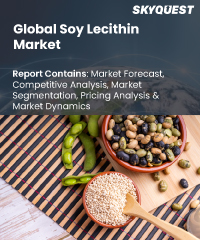
Report ID: SQMIG30C2113

Report ID:
SQMIG30C2113 |
Region:
Global |
Published Date: July, 2001
Pages:
157
|
Tables:
97 |
Figures:
76
With the biggest revenue share of more than 30% in 2021, Europe dominated the global soy lecithin market. This is explained by the fact that the region has a sizable number of lecithin producers. Demand is also being fueled by an abundance of raw resources and rising health consciousness among customers in the area. The 2.7 million tonnes of soybeans produced in the European Union over the years remained largely consistent. More than 15 million tonnes of soybeans and over 19 million tonnes of soybean meal were imported into the EU28+ in 2019. 243.880 tonnes of beans (195.104 tonnes of equivalent soybean meal) and 461.408 tonnes of the meal were exported, respectively, to nations outside the EU28+. The majority of the imported soybeans and soybean meal are used in the EU28+ for feed, food, and fuel after being crushed. In addition to direct soy imports, embedded soy is also imported into the EU28+ (263.087 tonnes), but embedded soy exports are far greater at more than 3 million tonnes, demonstrating the crucial role the EU28+ plays in animal-based agriculture.
The presence of significant end customers and the accessibility of raw resources in the North American region are the main drivers of demand. Large soy fields in the United States and canola farms in Canada are promoting market expansion in this region. One of the main sources used in the production of lecithin is soybeans. Soybean output in North America is rising as a result of extensive soy farming and an increase in the number of small-scale crushing plants. Production of soybeans reached a record high in 2021 of 4.44 billion bushels, up 5% from the previous year. The average soybean yield is anticipated to be 51.4 bushels per acre, which is 0.4 bushels more than 2020 and the second highest on record, with record-high yields in 21 states. An estimated 87.6 million acres will be planted with soybeans in 2021, an increase of 5% over the previous year. In 23 of the major producing States, planted acres have increased since last year. With 86.7 million acres expected to be harvested, this represents an increase of 5% from 2020. This would be the third-highest planted and harvested soybean acreage in history if realized.
Our industry expert will work with you to provide you with customized data in a short amount of time.
REQUEST FREE CUSTOMIZATIONSoy Lecithin Market size was valued at USD 547.5 million in 2019 and is poised to grow from USD 588.7 million in 2023 to USD 984.2 million by 2031, growing at a CAGR of 7.7% in the forecast period (2024-2031).
Want to customize this report? This report can be personalized according to your needs. Our analysts and industry experts will work directly with you to understand your requirements and provide you with customized data in a short amount of time. We offer $1000 worth of FREE customization at the time of purchase.

Report ID: SQMIG30C2113